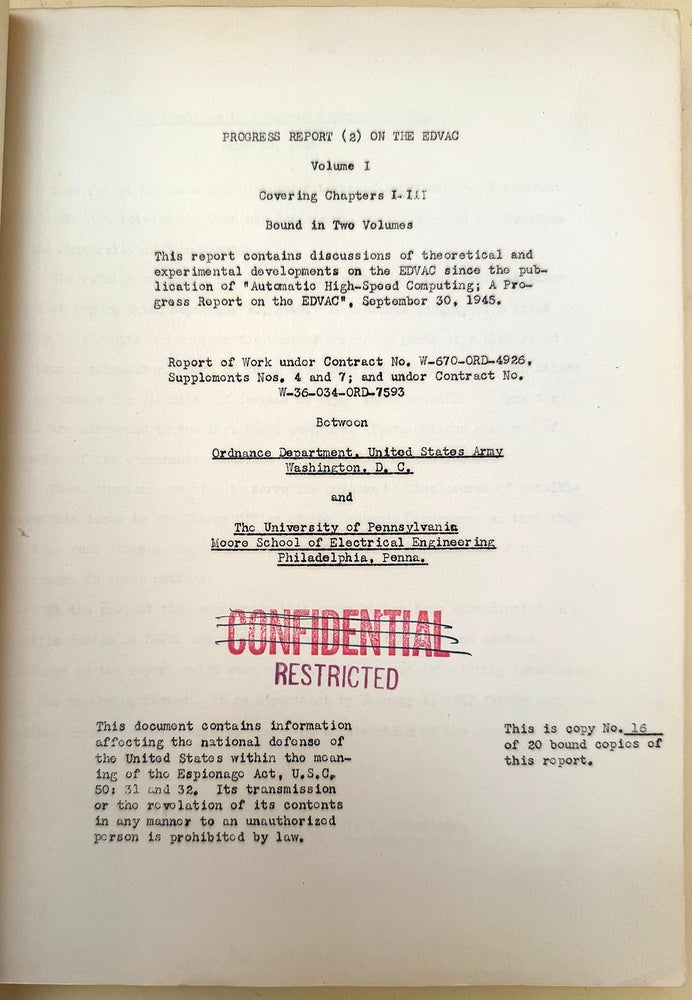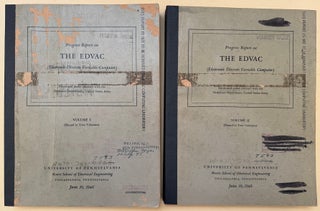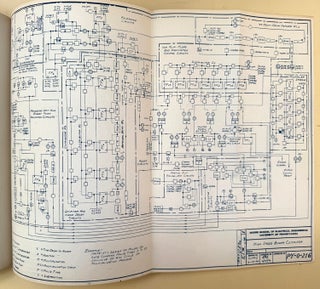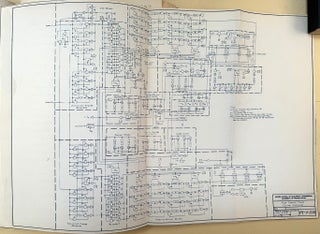Progress report (2) on the EDVAC. 2 vols. No. 16 of 20 copies
Publisher Information: Philadelphia: Moore School of Engineering, University of Pennsylvania, 1946.
[EDVAC.] Sharpless, Thomas Kite (1913-67). Progress report (2) on the EDVAC (Electronic Discrete Variable Computer. Mechanically reproduced typescript, printed on rectos only. No. 16 of 20 copies printed. 2 vols. [4], v, [135]; [4], vi-ix, [129]ff., variously numbered. 111 blueprint plates. Philadelphia: University of Pennsylvania, Moore School of Engineering, 30 June 1946. 279 x 214 mm. Original printed stiff wrappers, new cloth spines, worn, some staining from clear tape; boxed. Left margins of text leaves punched for binder, light toning, but very good. “Restricted” stamps on both front wrappers and some internal leaves. Classification markings crossed out on cover of vol. 2. Note toped to upper cover of both volumes reading “This report is not to be removed from the premises of the computing laboratory. Ownership stamps of Martin Weik (1922-2007), an engineer with the Aberdeen Proving Ground’s Ballistics Research Lab, who worked on both the ENIAC and EDVAC. From the library of Winifred S. Jonas (1924-2021), also of the BRL, an early programmer and operator of the ENIAC and EDVAC computers. Boxed.
Extraordinarily Rare First and Only Printing, one of only 20 copies issued, of the second progress report on the EDVAC, the first general-purpose electronic stored-program computer to be designed. The EDVAC’s revolutionary stored-program concept, initially described by John von Neumann in his privately distributed First Draft of a Report on the EDVAC (1945), became the paradigm for many of the first-generation computers, even though the machine itself was not completed until 1949 and did not become fully operational until late 1951.
The idea of a stored-program computer originated around 1943-44 at the University of Pennsylvania’s Moore School of Engineering, within the group of engineers charged with designing and constructing the ENIAC for the U.S. Army. The ENIAC, as is well known, was the world’s first general-purpose electronic computer, but it was not designed to store its instructions and to process the instructions and data in an electronic memory as electronic memory technology did not exist at the time; setting up programs on the machine required physically plugging in patch cords from buses to panels for the solution of each problem. By early 1944 some leading members of the ENIAC’s design team, including Pres Eckert, John Mauchly and Herman Goldstine, were actively pursuing the stored-program concept, and in September 1944 John von Neumann, the celebrated mathematical genius, joined what would become the EDVAC project. In October 1944 the U.S. Army granted the ENIAC team an additional $105,600 to explore the design of a stored-program computer. Among the technical stumbling blocks preventing development of a stored-program computer at that time was the problem of building a working electronic memory.
In June 1945 von Neumann wrote the First Draft of a Report on the EDVAC, setting forth in organized fashion the results of the EDVAC team’s design meetings; it was this document that “first described, in any detail, the concept of the stored-program computer” (Williams, p. 23). The First Draft was intended to be an internal working document, and as such it never received a “Restricted” or “Confidential” classification; however, its unclassified status led to the First Draft being distributed to a wider audience than anticipated, and since von Neumann was listed as the report’s sole author its readers naturally credited him with the stored-program concept. This led to friction between von Neumann and the other leading team members, several of whom—including Eckert and Mauchly—left the Moore School in early 1946, severely hampering further progress on the EDVAC. Prior to their departure Eckert and Mauchly attempted to set the record straight in their own report, titled “Automatic High Speed Computing: A Progress Report on the EDVAC” (30 September 1945), but this was a classified document issued in only 50 copies, and as such had only a limited audience.
After Eckert and Mauchly left the Moore School, responsibility for the EDVAC passed to Thomas Kite Sharpless, who headed the project until 1947. On 30 June 1946 Sharpless issued the second progress report on the EDVAC—the document we are offering here—describing the work done on the project since Eckert and Mauchly’s report of 1945. Like the earlier report, Progress Report (2) was a classified document, issued in only 20 copies. On the report’s “Acknowledgments” page Sharpless paid tribute to his EDVAC predecessors, particularly Herman Goldstine, Arthur W. Burks, John Mauchly and Pres Eckert; von Neumann’s name, for whatever reason, is conspicuously absent.
In 1949, five years after the stored-program idea was first conceived, the completed EDVAC was shipped to the Army’s Aberdeen Proving Ground for use in the Ballistics Research Lab. The EDVAC turned out to be a somewhat unreliable machine: It was difficult to program and operate, experienced long periods of down time, and had to undergo substantial upgrades to keep up with advancing technology and the BRL’s computing needs. Despite these limitations, the EDVAC remained in operation at the BRL until the end of 1962.
This copy was formerly owned by Martin Weik, an engineer with the Aberdeen Proving Ground’s Ballistics Research Lab who worked on both the ENIAC and EDVAC computers; between 1955 and 1964 he published four important surveys of all the known electronic digital computers in the United States. This copy was later owned by Winifred S. Jonas, an early programmer and operator of both the ENIAC and EDVAC. M. R. Williams, “The origins, uses and fate of the EDVAC,” IEEE Annals of the History of Computing 15 (1993): 22-38. Not in Origins of Cyberspace.
Book Id: 50642Price: $10,000.00






